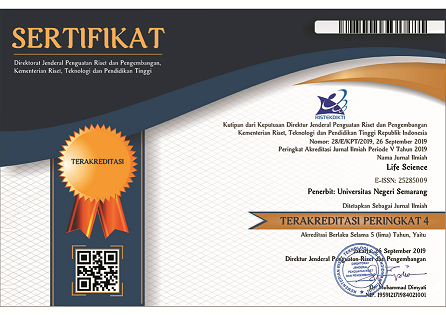Pengaruh Laju Injeksi Karbondioksida terhadap Oksigen Terlarut dan Pertumbuhan Spirulina platensis
DOI:
https://doi.org/10.15294/unnesjlifesci.v13.i2.14327Keywords:
Carbondioxide, Photobioreactor, Spirulina platensisAbstract
Indonesia has a high and continually increasing total greenhouse gas emission. Carbon dioxide absorption can be mitigated by utilizing the photosynthesis process of microalgae. Spirulina platensis was chosen as the sample to be cultivated in this study due to its ease of cultivation and its status as a large-scale carbon dioxide absorber. The objective of this research is to analyze the effect of varying carbon dioxide injection rates on dissolved oxygen and the growth of S. platensis. This research employed an experimental method involving semi-mass cultivation using a 12 L volume tube photobioreactor (PBR) as a container with three treatment variations. These variations included culture P0 (without injection/control), culture PA (0.5 L/minute), and culture PB (1 L/minute). The data analysis revealed that the variation with an increase in dissolved oxygen levels and enhanced growth of S. platensis was most optimal in culture PB (1 L/min). One-way ANOVA results showed significant differences between culture P0 (without injection) and classified data indicating that culture PB (1 L/min) fell into a high-level classification. The average dissolved oxygen value for culture PB (1 L/min) was 7.9 mg/L, with a cell density average of 0.651 cells/ml and a dry biomass weight of 3.8 grams. The conclusion drawn is that varying carbon dioxide injection rates significantly affect dissolved oxygen levels and the growth of S. platensis, as evidenced by cell density and biomass calculations. The effect on the S. platensis culture is a notable increase in both parameters. The application of varying carbon dioxide injection rates in the cultivation of S. platensis may serve as a reference for identifying the optimal carbon dioxide injection rate during semi-mass cultivation.
Downloads
References
Abdurrachman, O., Mutiara, M., & Buchori, L. (2013). Pengikatan Karbondioksida dengan Mikroalga (Chlorella vulgaris, Chlamydomonas sp., Spirullina sp.) dalam Upaya untuk Meningkatkan Kemurnian Biogas. Jurnal Teknologi Kimia dan Industri, 2(4), 212–216.
Anggraini, R. C. P. K., Kuntjoro, Y. D., & Sasongko, N. A. (2018). Potensi Pemanfaatan Mikroalga untuk Mitigasi Emisi CO2 (Studi Kasus di PLTU Cilacap). Ketahanan Energi, 4(1), 12-18.
Astiani, F., Dewiyanti, I., Mellisa. (2016). Pengaruh Media Kultur yang Berbeda terhadap Laju Pertumbuhan dan Biomassa Spirulina sp. Jurnal Ilmiah Mahasiswa Kelautan dan Perikanan Unsyiah, 1(November), 441–447.
Bahagia, B., & Viena, V. (2019). Analisis CO2 Pertumbuhan Mikroalga Hijau dengan Menggunakan Fermentor dalam Tanki Tertutup. Jurnal Serambi Engineering, 4(1), 464–470.
Buwono, N. R., & Nurhasanah, R. Q. (2018). Studi Pertumbuhan Populasi Spirulina sp. pada Skala Kultur yang Berbeda. Jurnal Ilmiah Perikanan Dan Kelautan, 10(1), 26–33. https://doi.org/10.20473/jipk.v10i1.8516
Choi, Y. Y., Patel, A. K., Hong, M. E., Chang, W. S., & Sim, S. J. (2019). Microalgae Bioenergy with Carbon Capture and Storage (BECCS): An Emerging Sustainable Bioprocess for Reduced CO2 Emission and Biofuel Production. Bioresource Technology Reports, 7, 100270. https://doi.org/10.1016/j.biteb.2019.100270
De Jesus Raposo, M. F., De Morais, A. M. B., & De Morais, R. M. S. C. (2015). Marine Polysaccharides from Algae with Potential Biomedical Applications. Marine Drugs, 13(5), 2967-3028. https://doi.org/10.3390/md13052967.
Elystia, S., Amelia, M. D., & Muria, S. R. (2020). Pengaruh Variasi laju Alir Gas CO2 terhadap Penyisihan COD dan Penyerapan CO2 oleh Chlorella sp. Menggunakan flat-photobioreactor pada POME. Jurnal Teknologi Pertanian Andalas, 24(1), 43–53. https://doi.org/10.25077/jtpa.24.1.43-53.2020
Ginasti, U. D., Dono, D., & Sunarto, T. (2020). The Effect of Neem Seed Oil (Azadirachta indica) and Clove Leaf Oil (Syzygium aromaticum) Mixture on Cabbage Head Caterpillars (Crocidolomia pavonana). Cropsaver, 3, 49. https://doi.org/10.24198/cropsaver.v3i2.29855
Hamdi, S., & Sumaryati, S. (2020). Pola Lama Penyinaran Matahari dalam 20 tahun Pengamatan di Sumedang. Jurnal Sains Dirgantara, 17(2), 81–94.https://doi.org/10.30536/J.JSD.2020.V17.A3111
Hariyadi, H. (2019). Terobosan Global Energi Terbarukan: Pembelajaran dan Implikasinya bagi Indonesia. Kajian, 22(1), 33–44.
Hidayati, S. (2020). Potensi Ekstrak Mikroalga Spirulina platensis Sebagai Antidiabetes pada Drosophila melanogaster yang Diinduksi Sukrosa. [Skripsi, UIN Sunan Gunung Djati Bandung]. Campua Repository. https://digilib.uinsgd.ac.id/34691/
International Energy Agency. (2024). CO2 Emissions in 2023. 4-5.
Ismaiel, M. M. S., El-Ayouty, Y. M., & Piercey-Normore, M. (2016). Role of pH on Antioxidants Production by Spirulina (Arthrospira) platensis. Brazilian Journal of Microbiology, 47(2), 298–304. https://doi.org/10.1016/j.bjm.2016.01.003
Kumar, K., Dasgupta, C. N., Nayak, B., Lindblad, P., & Das, D. (2011). Development of Suitable Photobioreactors For CO₂ Sequestration Addressing Global Warming Using Green Algae and Cyanobacteria. Bioresour Technol. 102(8):4945-53. https://doi.org/10.1016/j.biortech.2011.01.054.
Nugroho, A. P. (2017). Efek laju karbondioksida (CO2) terhadap Morfologi dan Laju Pertumbuhan Populasi Spirulina platensis (Gomont). Journal Penelitian Kehutanan FALOAK, 1(2), 75–84.
Pertiwi, I., & Wardani, A. K. (2019). Pengaruh Penambahan Karbondioksida (CO2) terhadap Pertumbuhan Isolat Mikroalga Spirulina platensis Skala Semi Massal. [Thesis, Universitas Brawijaya]. Campus Repository. https://repository.ub.ac.id/id/eprint/211111/
Sathakit, R., Ruangchuay, R., Luangthuvapranit, C., & Bovornruangroj, N. (2020). Effect of Carbon dioxide (CO2) Concentration on Growth of Ulva intestinalis in Photobioreactor. IOP Conference Series: Earth and Environmental Science, 416(1), 12020. https://doi.org/10.1088/1755-1315/416/1/012020
Setiawan, Y., Surachman, A., & Asthary, P. B. (2014). Pemanfaatan Emisi Gas CO2 untuk Budidaya Spirulina platensis dalam Upaya Penurunan Gas Rumah Kaca (GRK). Journal of Industrial Research (Jurnal Riset Industri), 8(2), 83-89.
Sitorus, T. B., Napitupulu, F. H., & Ambarita, H. (2014). Korelasi Temperatur udara dan Intensitas Radiasi Matahari terhadap Performansi Mesin Pendingin Siklus Adsorpsi Tenaga Matahari. Cylinder: Jurnal Ilmiah Teknik Mesin, 1(1), 8–17. https://ejournal.atmajaya.ac.id/index.php/cylinder/article/view/4276
Soni, R. A., Sudhakar, K., & Rana, R. S. (2019). Influence of Temperature and Light Intensity on the Growth Performance of Spirulina platensis. International Journal on Emerging Technologies, 10(2), 19–22.
Tambunan, A. L., Yuniar, I., & Trisyani, N. (2022). Kultur Pertumbuhan Mikroalga Spirulina sp. pada Media Asam, Netral dan Alkaline Skala Laboratorium. Fisheries: Jurnal Perikanan dan Ilmu Kelautan, 4(1), 28–37. https://doi.org/10.30649/fisheries.v4i1.62
Zendrato, T. S. (2019). Pemanfaatan Limbah Lindi terhadap Kelimpahan Chlorella sp [Skripsi,Universitas Islam Riau]. Campus Repository. https://repository.uir.ac.id/8479/1/144310095.pdf.












